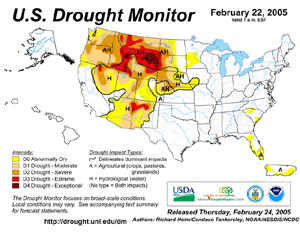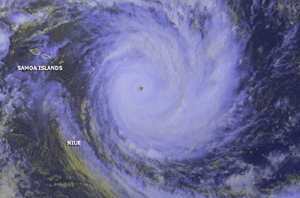
 India Avalanches |
Global Hazards and Significant
Events
|

| Wet weather in areas of the western United States which began during November continued through the winter season. This parade of Pacific storm systems ameliorated drought conditions in parts of the region, with areas of the Southwest (including California) receiving some of the most beneficial (but in some cases, excessive) precipitation. Extreme to exceptional drought persisted farther north throughout portions of the northern and central Rockies. |
 Larger Image |
| For comprehensive drought analysis, please see the current U.S. drought report. |
 Larger Image |
Long-term drought continued across areas of the Greater Horn of Africa and southern Africa. Despite recent rains, long-term drought continues in portions of southern Mozambique and adjacent parts of Zimbabwe and South Africa. For the latest African analysis and forecast, see the Famine Early Warning System Network. |

| Flooding rains that affected Guyana in January persisted into early February. In Georgetown, nearly 110 mm (4.3 inches) of rain fell during the first six days of February, which is close to the normal rainfall for the entire month (120 mm or 4.7 inches) (OCHA). |
 Larger Image |
 Larger Image |
Across Australia, Victoria recorded its highest statewide February rainfall since 1973. Many stations within the state received record 24-rainfall totals on the 2nd-3rd, including 120 mm (4.72 inches) at Melbourne (Australian BOM). |
| Across Venezuela and Colombia,
flooding rains on the 9th struck the mountainous central coast,
triggering landslides, destroying homes and washing out roads.
There were at least 86 deaths attributed to flooding and
landslides, with tens of thousands displaced from their homes
(Associated Press). In Pakistan, heavy rains in the south and snow in the north, triggered flooding and avalanches, killing at least 486 people during the second week of the month. Several dams throughout the country collapsed washing away homes, livestock, and entire villages, leaving thousands homeless. The air force, navy and army rescued hundreds of survivors and provided drinking water and food to many of the devastated villagers (OCHA/Associated Press). A storm system impacted parts of Arizona on February 12th, causing portions of four highways near the city of Globe, AZ to be closed due to rock slides and flooding. The heavy rain and snowmelt also forced several residents to evacuate their homes as a result of the flooding. No injuries or fatalities were reported. For an archive of flood events worldwide, see the Dartmouth Flood Observatory. |

| No reports of significant severe weather were received during February 2005. |

 Larger Image |
Tropical Cyclone Harvey developed in the Gulf of Carpentaria on the 6th, attaining tropical storm strength before moving inland near the Sir Edward Pellew Island Group in Australia's Northern Territory on the 7th. Maximum sustained winds at the time of landfall were near 95 km/hr (50 knots or 60 mph). Heavy rainfall accompanied the cyclone as it weakened quickly on its trek inland. |
| In the South Pacific, Tropical Cyclone Olaf passed within 97 km (60 miles) of coastal areas of Samoa, American Samoa and the Cook and Manua Islands on February 15-16. Sustained wind speeds of 258 km/hr (140 knots or 160 mph) were reported, with gusts up to 306 km/hr (165 knots or 190 mph), downing power lines, trees and ripping roofs from houses. Heavy rains and high storm surge also impacted the islands, causing coastal flooding and displacing thousands of people. No injuries or fatalities were reported, although American Samoa was declared a disaster area. On the island of Ta'u, nearly every house in the village of Fitiuata was destroyed (Associated Press/Reuters). |
 Hurricane Olaf |
 Larger Image |
Tropical Cyclone Percy developed on the 25th in the South Pacific Ocean, and affected Tokelau on the 26th with maximum sustained winds near 175 km/hr (95 knots or 110 mph). Percy produced widespread damage to the three atolls of Atafu, Nukunonu and Fakaofo. Percy passed through American Samoa and the northern Cook Islands on the 28th, causing widespread damage to Pukapuka on the 28th as maximum sustained winds were near 240 km/hr (130 knots or 150 mph). On Pukapuka (population 600), only 10 houses weathered the cyclone intact, with the remaining structures severely damaged or destroyed (OCHA). |
| For 2005 basin tropical cyclone
statistics, please refer to the following: Australian Basin North Indian Ocean Basin Northwest Pacific Basin South Pacific Basin South Indian Ocean Basin |

| No reports of significant extratropical cyclones were received during February 2005. |

 Larger Image |
Heavy snow that began January in Tajikstan continued in early February. Significant snowfall accumulations caused roofs to collapse on hospitals, schools and private homes. In mountainous areas of the country, key populated valleys were completely cut off from the rest of the country. In Tavildara, as much as two meters of snow (6.6 feet) had accumulated by February 10. In the Rasht Valley, over a hundred major avalanches affected populated areas, trapping hundreds of vehicles, and killing 9 people (OCHA). |
| Heavy snow fell in parts of Europe during the first few days of the month, including portions of Austria, Germany, Albania, Bulgaria and Greece. In Bulgaria, authorities declared a state of emergency for eastern regions of the country, as heavy snowfall closed airports and produced 1-meter (~6-feet) drifts that trapped around 100 vehicles near the city of Varna. There were 4 deaths in Bulgaria blamed by the cold and snow (Associated Press). |
 Larger Image |
 Click For Animation |
Extremely cold temperatures affected much of the Balkan region for the first half of the month. In Sevlievo, Bulgaria, a 50-year temperature record was broken when temperatures reached as low as -34°C (-29°F). At least 12 fatalities occurred in the region. Hospitals in central Bosnia were closed when heating systems malfunctioned due to -29°C (-20°F) temperatures. The surviving snowbound villagers had to fight off hungry wolves and wild boar searching for food (Reuters). |
| In the Kashmir region along the India/Pakistan border, snowfall described as the worst in two decades affected parts of the Himalayan region during February 16-20. In India, at least 230 people were killed due to the extreme winter weather (OCHA/Reuters). Snowfall accumulations reached 2 meters (6.6 feet) in some parts of Jammu and Kashmir states in India. |
 Larger Image |
| In Iran, nearly a week of snowfall occurring during the first half of February brought accumulations of up to 50 cm (20 inches) in the northern parts of the city of Tehran. This was most snow accumulation in the city since 1964. |
References:Basist, A., N.C. Grody, T.C. Peterson and C.N. Williams, 1998: Using the Special Sensor Microwave/Imager to Monitor Land Surface Temperatures, Wetness, and Snow Cover. Journal of Applied Meteorology, 37, 888-911. Peterson, Thomas C. and Russell S. Vose, 1997: An overview of the Global Historical Climatology Network temperature data base. Bulletin of the American Meteorological Society, 78, 2837-2849. |
 NOAA's National Centers for Environmental Information
NOAA's National Centers for Environmental Information